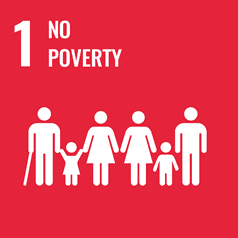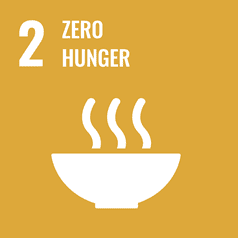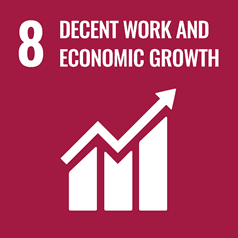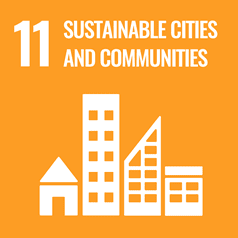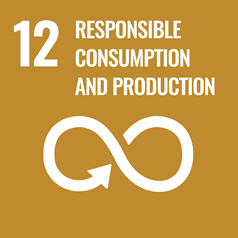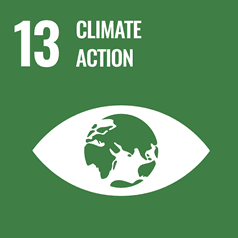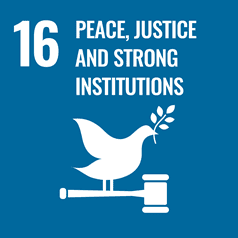Our progress
As a public institution entrusted with stewardship of public and stakeholder funds, we are monitoring our performance against a number of measures of success to ensure that we are delivering on both the 'what' and 'how' of our mission.
In doing so, we hold ourselves accountable to our students, staff and our regions. Celebrating our achievements and milestones along the way is an important part of this. Here, we share the advances we have made to date.
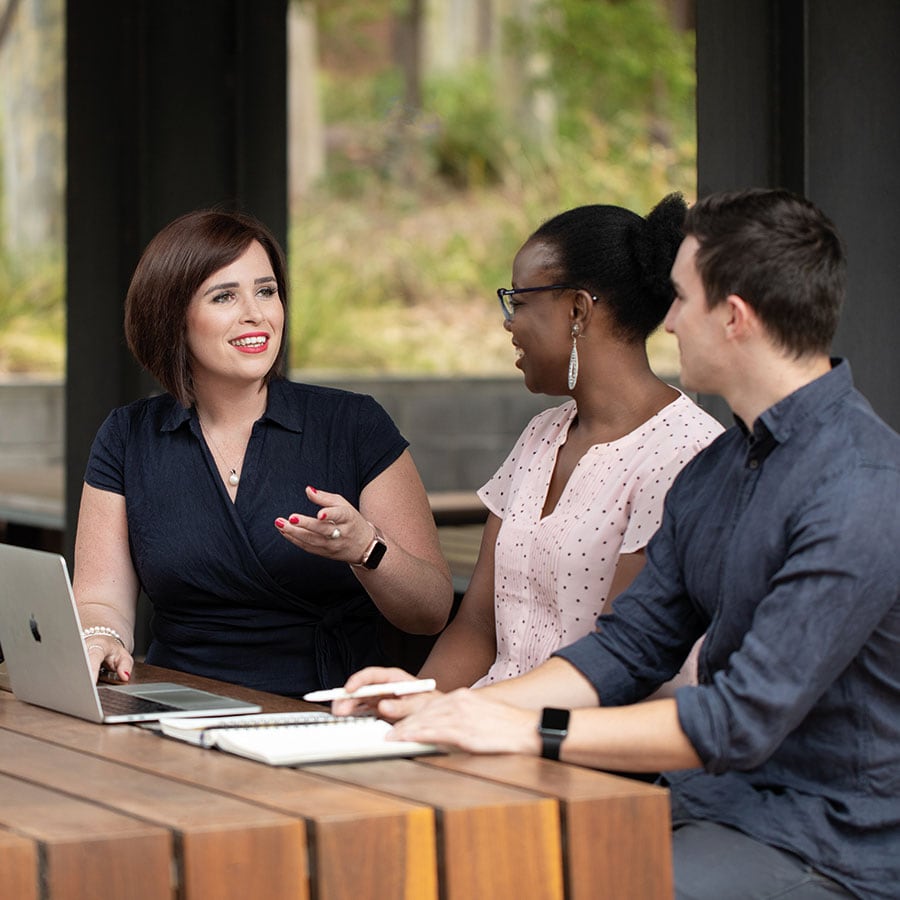 Staff members: Alisha-Jane Laney, Taona Afful and Brock Johnston
Staff members: Alisha-Jane Laney, Taona Afful and Brock Johnston
Implementation
Implementing
our strategy
Achieving our ambitious plan will require focus across the organisation and collaboration with our communities, partners and civic leaders. As a one-university region with a unique industrial base, we are the natural partner for deep industrial, commercial and social opportunities. The alignment of our strategic priorities, enabling strategies, business systems, and processes will be fundamental to success.
Ongoing monitoring and evaluation of our progress and outcomes will be critical to ensuring our activities are directed toward achieving our vision.
We will establish a strategy framework to reflect our Engagement Priorities and realise our Life-Ready Graduates outcomes, defining the relationship between core strategic priorities, enabling strategies and key initiatives.
A core objective for our institution is to remain financially sustainable. We will identify methods to diversify our revenue streams in our strategic plan delivery, including but not limited to, our philanthropic capacity and the development of key partnerships to cooperatively fund mutually beneficial activities.
We will respond to higher education dynamics, advances in technology and changing markets by being innovative in our business and delivery models, reflecting the needs and preferences of our students and our communities.
We will pilot innovative business models for the delivery and verification of knowledge such as micro-credentials. We will explore new ways of delivering what our stakeholders want in a manner that meets their evolving expectations.
We will aim to generate a core operating surplus that allows us to invest in our talent, programs and infrastructure into the future.
A financial scorecard will be aligned to our strategy to monitor and evaluate our progress, ensuring key financial measures are in place. We will manage and evaluate the successful delivery of the portfolio in partnership with divisions and faculties and will continually monitor our strategic alignment by prioritising our investments.
We will build on our Advancement Strategy to establish a philanthropic mindset within the University and align our advancement programs to our strategic priorities. We will continue to engage with our alumni communities and our generous philanthropic supporters to build our readiness to launch comprehensive alumni and philanthropic campaigns.
We will improve business processes to deliver on our strategic plan. We will take a collaborative, problem-solving approach to identifying process blocks and designing solutions that improve staff and student experience, as well as service efficiency and effectiveness. This will include consultation and partnership across relevant stakeholder groups, including students.
These include but are not limited to:
- administrative processes associated with career-ready placements, industry mobility, student enquiries, admissions and enrolments, student academic and wellbeing support, student accommodation and research support
- consulting on options for reimagining our campuses
- support for researchers through grant development, project support and commercialisation processes
- staff recruitment and retention processes
- digital solutions to support our activities and engagement.
Sustainable Development Goals
Alignment with National
and Global objectives
The University of Newcastle is committed to aligning our strategic priorities to the United Nations Sustainable Development Goals (SDGs).
We are proud to be home to Australia's only United Nations Institute for Training and Research (UNITAR) accreditedInternational Training Centre for Authorities and Leaders (CIFAL) institute and the only University in Australia to fly the United Nations flag.
We will benchmark our strategic activity against the 17 SDGs, providing a globally recognised framework to measure our impact. Our strategy is also inspired by the Alice Springs (Mparntwe) Education Declaration, which sets a vision for a world-class education system for all Australians that promotes equity and excellence, and creates successful lifelong learners who are active and informed members of the community.
We will support the achievement of the Declaration's Goals and Commitments to Action through our University's activities.
Scroll the table below side-to-side to see how our strategic priorities align with the United Nationals sustainable development goals.
Strongly Aligned Aligned
Phasing
Phasing for
our strategy
The phasing of our strategy is reflective of our estimated effort over time. It has been reviewed annually to reflect new developments and the latest prioritisation of our efforts.
Scroll the table below side-to-side to see how our strategic will be phased in over the next 5 years.
| Strategic Priorities | Initiative | 2020 | 2021 | 2022 | 2023 | 2024 | 2025 | ||||||
|---|---|---|---|---|---|---|---|---|---|---|---|---|---|
| Our Indigenous commitment |
Increased student participation and retention | Lower intensity of effort | Maximum effort | Maximum effort | |||||||||
| Preferred employer | Maximum effort | Scale up / Transition | Lower intensity of effort | ||||||||||
| Leading Indigenous research | Scale up / Transition | Maximum effort | Maximum effort | ||||||||||
| Leading reconciliation across our communities | Scale up / Transition | Maximum effort | Scale up / Transition | Lower intensity of effort | |||||||||
| Engagement Priorities |
Living Lab model | Scale up / Transition | Scale up / Transition | Maximum effort | Scael up / Transition | Lower intensity of effort | |||||||
| Multidisciplinary networks | Scale up / Transition | Maximum effort | Lower intensity of effort | ||||||||||
| Engagement pathways | Lower intensity of effort | Scale up / Transition | Maximum effort | Scale up / Transition | |||||||||
| Institutional alignment | Maximum effort | Maximum effort | |||||||||||
| Life ready graduates |
Career-ready placements for all | Lower intensity of effort | Scale up / Transition | Maximum effort | Maximum effort | ||||||||
| Graduate attributes | Lower intensity of effort | Scale up / Transition | Maximum effort | Scale up / Transition | Lower intensity of effort | ||||||||
| Celebrating excellence | Lower intensity of effort | Scale up / Transition | Maximum effort | Scale up / Transition | Lower intensity of effort | ||||||||
| Student-centred wellbeing | Lower intensity of effort | Scale up / Transition | Maximum effort | Scale up / Transition | Lower intensity of effort | ||||||||
| Asia Pacific focus |
Asia Pacific partnerships | Lower intensity of effort | Scale up / Transition | Maximum effort | Maximum effort | ||||||||
| Globally engaged education | Lower intensity of effort | Maximum effort | Lower intensity of effort | Lower intensity of effort | |||||||||
| Empowered and connected | Lower intensity of effort | Scale up / Transition | Maximum effort | Scale up / Transition | Lower intensity of effort | ||||||||
| Our Asia Pacific hubs: Sydney and Singapore | Scale up / Transition | Maximum effort | Lower intensity of effort | ||||||||||
| Reimagining our campuses |
Reposition existing estate | Lower intensity of effort | Maximum effort | Maximum effort | |||||||||
| New partners, new uses | Maximum Effort | Maximum effort | |||||||||||
| Digital excellence | Scale up / Transition | Maximum effort | Maximum effort | ||||||||||
| Places to live, learn, work and play | Scale up / Transition | Maximum effort | Maximum effort | ||||||||||
| Campus accessibility | Scale up / Transition | Maximum effort | Maximum effort | ||||||||||
| Sustainable campuses | Maximum effort | Maximum effort | |||||||||||
| Inspiring people |
A high-performing institution | Scale up / Transition | Maximum effort | Scale up / Transition | Lower intensity of effort | ||||||||
| Building leadership and capability | Scale up / Transition | Maximum effort | Scale up / Transition | Maximum effort | |||||||||
| Outstanding talent | Lower intensity of effort | Scale up / Transition | Maximum effort | Lower intensity of effort | |||||||||
| A values-based culture | Scale up / Transition | Maximum effort | Lower intensity of effort | ||||||||||
| Healthy and safe workplace | Maximum effort | Maximum effort | |||||||||||
| Lower intensity of effort | Scale up / Transition | Maximum effort |
2025 Implementation Plan
2025 Looking Ahead
Implementation Plan
In the final year of the Looking Ahead Strategic Plan, this Implementation Plan marks a pivotal phase for the University to consolidate initiatives and set the foundation for our future strategic direction. While it cannot capture all of the University’s activities or efforts, our staff will focus on concluding work already commenced, embedding it into business as usual, and progressing longer term priorities that will continue beyond the life of Looking Ahead. Additionally, we will maintain and continuously improve the quality of our operations. Throughout 2025, our strategic efforts will align with Business Improvement Program (BIP) projects, which are reflected in the refreshed format of our Implementation Plan.
The initiatives included in this Implementation Plan continue to focus on the interests of our unique region, building connectedness within our student community, and growing opportunities for students and staff to engage with industry.
Our Indigenous Commitment
Executive Leads
- Deputy Vice-Chancellor (DVC) Engagement and Equity
- Director, Aboriginal and Torres Strait Islander Research Strategy and Leadership
Our Strategies
- Creating an ecosystem for Indigenous research by establishing a Health Research cluster and research pathways, including Post-Doctoral programs and Higher Degree Research (HDR) development programs. (Q1-Q4)
- Developing and implementing student retention programs for Indigenous students, with a particular focus on programs in the College of Engineering, Science and Environment; Education; and Nursing and Midwifery. (Q1-Q4)
Measures of Success
^ Interim target
Engagement Priorities
Executive Leads
- Deputy Vice-Chancellor (DVC) Research and Innovation
- Pro Vice-Chancellor (PVC) Engineering, Science and Environment
Business Improvement Program (BIP) alignment
- Research Impact — Consider our research strengths, regional and global need, and external funding opportunities to focus our efforts where we can have the greatest impact.
Our Strategies
(Bold denotes BIP initiatives)
- Aligning our internal investments with strategic research priority areas, including the implementation of revenue and investment models for relevant business units and research institutes. (Q1-Q4)
- Driving our strategic research priority areas through activating our Living Labs (Q1-Q2) and implementing engagement roadmaps developed with our institutes. (Q1-Q4)
- Ongoing implementation of the Trailblazer Recycling & Clean Energy (TRaCE) collaboration with the University of New South Wales, and the DeCarb Hub project. (Q1-Q4)
- Developing new research connections through our Prime research partnerships strategy, building programs of work with major partners globally. (Q1-Q4)
- Implementing the Asia-Pacific research strategic plan. (Q1-Q4)
- Securing at least one ARC, NHMRC and/or CRC Centre of Excellence for 2025. (Q1-Q4)
Measures of Success
Life Ready Graduates
Executive Leads
- Deputy Vice-Chancellor (DVC) Academic
- Head of School (HOS) Information and Physical Sciences
Business Improvement Program (BIP) alignment
- Academic Offering — Shape an innovative and flexible program offering and student experience to attract and retain a diverse student load that sustains the University.
Our Strategies
(Bold denotes BIP initiatives)
- The Program and Calendar Flexibility project will see the development of new academic program structures for implementation in 2026 and delivery of the Timetabling system. (Q1-Q4)
- Conduct a comprehensive review of our Academic offerings to ensure alignment to student and community need, and embed governance to ensure ongoing systematic review. (Q1-Q4)
- Finalise systems to progress Career Ready Placements to BAU, and complete mapping of Graduate Attributes. (Q1-Q4)
- Continued focus on employability and career workstreams to celebrate excellence, including ILEAD, Career Connect, Employability Awards and the Industry Open Day. (Q1-Q4)
- Student Centred Wellbeing programs focused on mental health, wellness and connection to the University. (Q1-Q4)
- Implement Artificial Intelligence (AI) initiatives that enhance teaching, learning and assessment, as well as uplift the capability of students and staff. (Q1-Q4)
- System enhancements to improve user experience opportunities to improve Credit and RPL (Q1), post discovery work on a student engagement and communications platform (Q1-Q2), a critical case management workflow tool for student safety and conduct (Q1-Q3), and the phased roll out of adverse circumstances. (Q2-Q4)
- Establishing a Quality Framework that will improve the Course Assessment Review, Program Annual Review and External Program Review. (Q1-Q4)
Measures of Success
Asia Pacific Focus
Executive Leads
- Pro Vice-Chancellor (PVC) Global Partnerships
Our Strategies
- Building existing and developing new partnerships in China and India, growing relationships in Vietnam and Indonesia, and exploring new markets (Q1-Q4)
- Adjusting our International Student Recruitment Plan based on evolving Government settings, end executing particularly in China, India and the Association of Southeast Asian Nations (ASEAN).
- We will complete a feasibility study for a major philanthropic campaign (Q1) and target May for the launch of campaign-badged activations (Q2).
- Progressing the Singapore EduTrust Comprehensive Strategic Partnership. (Q1-Q4)
- Review our Sydney Campus Strategy in alignment with government settings (Q1) and launch an Expression of Interest process for a Managed Campus Agreement. (Q1-Q2)
Measures of Success
Reimagining Our Campuses
Executive Leads
- Chief Operating Officer (COO)
- Pro Vice-Chancellor (PVC) College of Human and Social Futures
Business Improvement Program (BIP) alignment
- Fit for Purpose Infrastructure — Maintain contemporary physical and digital infrastructure and assets that are fit for purpose and affordable.
Our Strategies
(Bold denotes BIP initiatives)
- Delivering projects that enhance learning and research experiences while ensuring all campuses are safe and accessible, including;
- Central Coast Campus
- Campus Heart precinct developments
- Stage 1 High Voltage infrastructure project.
- Enhancing the student campus experience by planning for fit for purpose student accommodation at Callaghan, City and Central Coast campuses and Alumni and Community House (Q1-Q4)
- Future-proofing digital environments with the delivery of Research Enablement, Teaching and Learning, Artificial Intelligence, Cyber security and Compliance programs. (Q1-Q4)
- Continued focus on Core Business and Enterprise platforms, including service management and CRM, contract lifecycle management; Finance and MyHR systems projects. (Q1-Q4)
- Reduce Scope 3 emissions, with a focus on travel and commute initiatives (Q1-Q2) and offsetting residual Scope 2 emissions (Q3-Q4)
- Apply a laboratory operations focus (Q1-Q2) to waste and recycling and pilot waste and recycling initiatives (Q3-Q4)
Measures of Success
Inspiring People
Executive Leads
- Chief People and Culture Officer
Business Improvement Program (BIP) alignment
- People and Processes — Innovate our operations and workforce to be more efficient and effective in supporting students, staff and communities.
Our Strategies
(Bold denotes BIP initiatives)
- Implement the business model review recommendations to ensure efficient and contemporary service delivery between professional and academic parts of the organisation
We will empower and develop our staff by:
- Fostering great leadership practices through the development and implementation of leadership capability programs, with a particular focus on Executive and Senior Leadership Teams Effectiveness Program and Leader onboarding programs and tools. (Q1-Q4)
- Implementing a succession planning framework to grow our leadership capability. (Q1-Q4)
- Promoting our Values-based Culture by celebrating success across the organisation. (Q1-Q4)
- Embedding our Core and Segmented Employee Value Propositions, increasing our ability to attract, nurture and retain outstanding talent. (Q1-Q4)
- Finalise implementation of our Psychosocial Health and Safety Framework building on a Respectful Workplace and focusing on prevention of psychological harm. (Q1-Q4)
Measures of Success
Previous implementation plans: 2024 plan, 2023 plan, 2022 plan, 2020-2021 report (PDF, 7.6MB)
.KPIs and Targets
Scroll the table below side-to-side to view the full our KPIs and targets.
| Looking Ahead KPI | Unit | Actual | Target | |||||
|---|---|---|---|---|---|---|---|---|
| 2021 | 2022 | 2023 | 20241 | 2025 | ||||
| Our Indigenous Commitment | ||||||||
| Excellence | 1 | Research income with Indigenous Chief Investigator | $M | 0.6 | 2.2 | 5.0 | 1.7 | 3.0 |
| Equity | 2 | Indigenous staff participation | % | 3.0 | 3.2 | 3.3 | 3.3 | 4.0 |
| Engagement | 3 | Indigenous student retention (Variance) | % | -2.4 | -4.5 | -4.4 | -3.4 | 0 |
| Sustainability | 4 | Staff completion of Cultural Competency Modules | % | 43.4 | 79.1 | 87.7 | 90.4 | 100 |
| Engagement Priorities | ||||||||
| Excellence | 5 | Average World Rank (External Rankings) | Rank | 276 | 267 | 282 | 283 | 250 |
| Equity | 6 | Projects with Industry/Community Partners | % | 43.2 | 44.4 | 39.2 | 39.1 | 51 |
| Engagement | 7 | Multidisciplinary collaboration | % | 23.5 | 25.1 | 26.0 | 24.3 | 25 |
| Sustainability | 8 | HERDC Income | $M | 134 | 127 | 150 | 128.72 | 150 |
| Life Ready Graduates | ||||||||
| Excellence | 9 | Quality of Overall Experience (SES) | # | 72.6 | 76.4 | 78.3 | 78.8 | 81.4 |
| Equity | 10 | Disability retention (Variance to Overall Retention) | % | -4.4 | -4.0 | -4.1 | -4.2 | 0 |
| Engagement | 11 | Career-ready placement participation3 | % | N/A | 86.4 | 94.9 | 96.8 | 100 |
| Sustainability | 12 | K10 Risk Scale | # | 25.1 | N/A | 22 | 24.8 | 21 |
| Asia Pacific Focus | ||||||||
| Excellence | 13 | International co-publications | % | 55.5 | 54.1 | 57.6 | 54.6 | 60 |
| Equity | 14 | Outbound student mobility | # | 180 | 405 | 930 | 1065 | 1250 |
| Engagement | 15 | Philanthropic and Sponsorship Income | $M | 14.7 | 36.4 | 56.8 | 75.5 | 75 |
| Sustainability | 16 | Proportion of FPI EFTSL | % | 9.4 | 9.5 | 11.8 | 11.3 | 18.5 |
| Reimagining Our Campuses | ||||||||
| Excellence | 17 | Satisfaction with physical and digital environments | % | 72.8 | 73.5 | 73.5 | 77.9 | 80 |
| Equity | 18 | Satisfaction with campuses and facilities (Student with a disability variance to overall) | % | -6.8 | -5.9 | -6.4 | -5.1 | 0 |
| Engagement | 19 | WiFi utilisation | # | 76 | 108.6 | 132.1 | 139.6 | 140 |
| Sustainability | 20 | Carbon emissions (tonnes) | ‘000 | 27.6 | 41.0 | 46.0 | TBC | 0 |
| Inspiring People | ||||||||
| Excellence | 21 | Share of UAC first preferences | % | 11.3 | 11.4 | 10.4 | 11.9 | 11.9 |
| Equity | 22 | Senior Academic Women | % | 33.5 | 34.3 | 34.9 | 35.6 | 37.5 |
| Engagement | 23 | Your Voice Staff Engagement | % | 72.8 | N/A | 70 | N/A | 80 |
| Sustainability | 24 | Safe Work Australia Maturity Score | # | 2 | 2 | 2 | 2 | 3 |
1 Data as at 31 December 2024
2 Data as at December 2024. FY 2024 results are unaudited and excludes most research income outside Research Grants and TUNRA.

Central Coast twins tackle university to support local mob
Juggling work, study and sport could be challenging for Wiradjuri/Gomeroi twins, Bailey and Leigtham, but there is a clear mission that drives them forward.
Read more

Commonwealth Supported Place postgrad initiative empowers Kieran to pursue surgical dreams
Kieran Cubby, a proud Wiradjuri/Murrawarri man from Dubbo, is on a determined path to becoming an orthopaedic surgeon – a dream that once seemed out of reach.
Read more
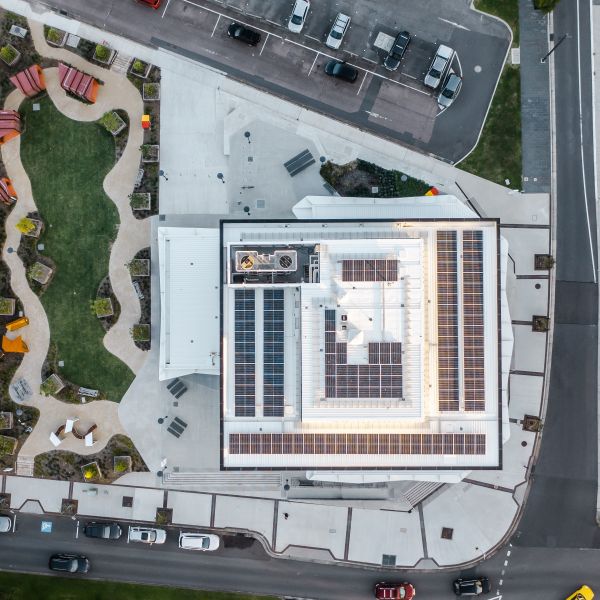
University of Newcastle ranked 2nd in World for Climate Action
The University of Newcastle’s strong commitment to sustainability has been recognised globally, with the university ranking second in the world for Climate Action in the 2025 Times Higher Education Impact Rankings.
Read more

Outstanding community members celebrated in 2025 Australia Day Honours
The University of Newcastle extends its congratulations to all recipients who have been recognised in the 2025 Australia Day Honours, particularly celebrating those that make up a growing and important part of our University community.
Read more

University secures $20.7m innovation facility - a fast track to net zero for industry
Prime Minister Anthony Albanese has today visited the University of Newcastle to announce $20.7 million in funding to develop a ‘Future Industries Facility’ at the university’s Callaghan Campus. It will bring together undergraduate students, SMEs and community from across the Hunter to test and scale-up new technology and upskill people.
Read more

Ngarrama returns to light up Newcastle
Ngarrama will illuminate King Edward Park on Saturday 25 January when the University of Newcastle proudly welcomes the community back for its annual reflection event.
Read more
Traditional Custodians
The University of Newcastle acknowledges the traditional custodians of the lands within our footprint areas: Awabakal Nation, Darkinjung Nation, Biripai Nation, Worimi Nation, Wonnarua Nation and Eora Nation. We also pay respect to the wisdom of our Elders past and present.
The University of Newcastle acknowledges the traditional custodians of the lands within our footprint areas: Awabakal, Darkinjung, Biripai, Worimi, Wonnarua, and Eora Nations. We also pay respect to the wisdom of our Elders past and present.
